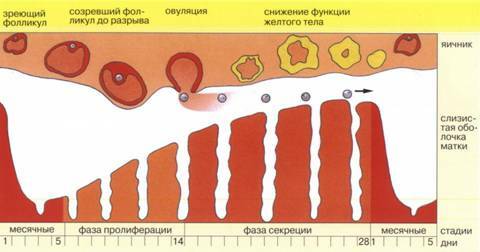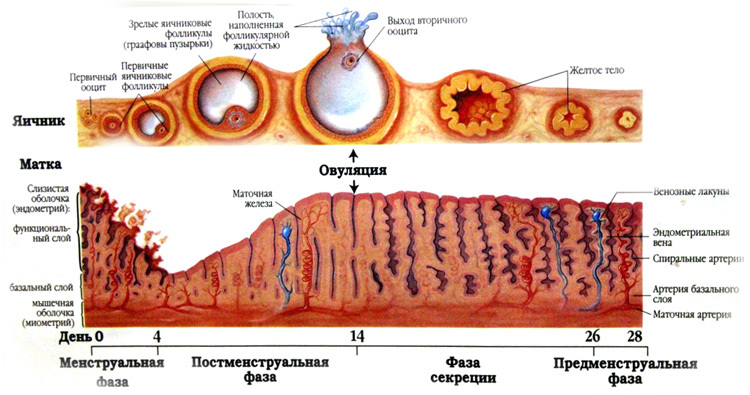The issue of fruiting is vitally important for women - and those who want to conceive, and those who do not even think about parenting. What are the chances of conception before and after menstruation, and is there a period of absolute sterility, of which gynecologists speak?
What happens during menstruation?
A woman fructifies only 4% of her life. During each monthly cycle, the days of conception are a short period. The cycle of menstruation in different women can be from 21 to 36 days. However, most often - 28. Even for the same woman, the cycle can change for a number of reasons.
The menstrual cycle of a woman is as follows: in one of the ovaries, the egg begins to mature. It arises in the so-called.bubble Graaff( it was discovered in the XVII century by the Dutch Ranier de Graaf).The vesicle appears on the surface of the ovary as a bulge and ripens about a week. But! This process can accelerate or slow down due to various factors( stress, infection, lack of sleep, climate change or time zone).As a result, the cycle can be unpredictably elongated or shortened.
When the blister ripens, the ovary increases the production of the hormone estrogen. And that promotes the rupture of the vesicle and the release of the egg, which is picked up by the leuco-shaped end of the oviduct. This phenomenon is called ovulation. This is the culmination moment of the cycle and the peak of the probability of conception. The released egg moves along the oviduct to the uterus. Her life is short: if during the day there is no fertilization, the egg begins to die.

Thus, in the first, pre-ovulatory phase of the cycle, estrogen acts, which:
- Helps rupture of Graaf bubbles
- Promotes the renewal of the mucous membrane of the uterus
- Stimulates the glands in the cervix, producing a special mucus in which spermatozoa are well preserved. That's why spermatozoa live in a woman's body for 3-7 days.
The bursting bubble of Graaff in the second phase of the cycle creates a yellow body that secrete the second important hormone, the progesterone.
In the second phase of the cycle, there is a progesterone that:
- Brakes mucus secretion favorable for sperm preservation
- Causes thickening of the uterine mucosa and accumulation of nutrients in it for the adoption of an already fertilized egg.
- Blocks the maturation of the following Graaf bubbles. This means that the next ovulation in this cycle is impossible. This process causes an increase in the basal temperature by several divisions and is the most obvious sign of ovulation.
If fertilization has not taken place, all the body preparations of a woman for adoption of the embryo become unnecessary. The yellow body begins to dissolve after 10-16 days from ovulation, which causes a drop in the level of progesterone in the blood. The body temperature drops, the mucous membranes of the uterus exfoliate, their excess is removed from the blood from the bursted sosudikov. Monthly - a large cleaning after the failed conception. The next day the cycle begins anew.
Three phases of the cycle - three degrees of fetal / infertility

- The first is the phase of relative predovulatory infertility. Why is it called relative? Because its duration varies depending on the maturation time of the Graaf bubble. In the case of a short ovulation cycle, the egg develops so quickly that the days of conception may occur at the end of menstruation. In this situation, you can get pregnant even during periods. In the case of a normal cycle lasting about 28 days, the menstrual cycle is a barren woman's day.
- The second phase is the time of onset of ovulation, when the ovum leaves the ovary in the oviduct. She lives a day and can be fertilized during these 24 hours. But spermatozoa live in the mucus of a woman for 3-7 days, so 5 days before the release of the egg should also be considered a time when conception is possible. Three to four for after ovulation are also a time of possible conception.
- The third phase is the phase of absolute infertility( sterility).It lasts usually about 14 days, that is, from the moment of egg death to monthly. This is a constant phase. The day of ovulation can be calculated if we subtract 14 days from the date when the monthly periods are expected. For example, if menstruation is scheduled for April 25, then on April 11 ovulation should occur. Given that spermatozoa live 3-7 days, seven days before April 11 and 3-4 days after this date, one should refrain from unprotected sex if pregnancy is unacceptable.
Why is there absolutely no safe days
Counting 14 days from the estimated date of monthly does not give absolute certainty. As a result of stress, illness, medication, climate change, lack of sleep and other factors, bleeding may be delayed or come earlier. However, if, in addition to calculations, daily measuring the temperature in the rectum and observing the release of mucus from the vagina, days favorable for conception can be calculated with great accuracy. Worse with the calculation of days of absolute sterility. It is because of the approximations of the calculations that the natural method of contraception leads in 9-25 cases out of 100.
Conclusions:
- You can "fly in" if the sexual intercourse occurred almost at any time of the cycle - at any days of conception before and after the menstrual period.
- For the 28-day cycle, the peak of conception is from 11 to 16 days. For a 30-day - from 13 to 18.
- Any unprotected sexual intercourse, even interrupted, can turn into conception. It depends not only on the woman's cycle, and on the vitality of male spermatozoa, but also on the immune compatibility of the couple. Spermatozoa are perfectly preserved in the fetal mucus of a woman.
- Use the calculation of the cycle for a qualitative conception, but do not rely on it for protection in particular.
Can I get pregnant with menopause and amenorrhea?
Yes, you can. Amenorrhea( absence of menstruation) does not exclude the possibility of ovulation, which means it is quite possible to "fly", although this possibility is reduced.
It is incorrect to assume that amenorrhea during lactation protects a woman from the next pregnancy. The first ovulation after the birth of a child can take place before the first menstrual bleeding.
Absence of menstruation for several months does not guarantee safety. The woman retains the ability to become pregnant within 12 months after the last menstrual period. Only a year later you can believe that the activity of the ovaries has died down and ovulation has not occurred. However, for complete peace of mind, it is better to go to a doctor and examine the level of hormones in the blood. It is possible that the absence of menstruation is due to other causes.
As you can see, the monthly ones come and go, but they do not bring any guarantees with them. Possible conception after menstruation, monthly after conception. Life is unpredictable from its inception.
